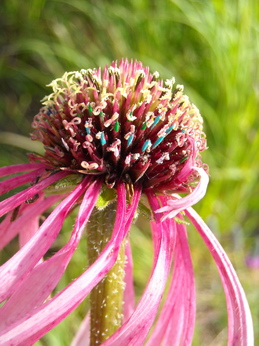This summer I’m building off of Nicholas’ work with E. angustifolia and E. pallida hybridization. I uploaded my proposal last week, but I’ve already learned a lot since then.
First of all, after first thinking that I should be collecting pollen, painting bracts, observing styles and crossing all on the same day, Stuart pointed out that it would be better to do crosses one day and everything else the next. It makes things go faster, and it is also easier to tell which bracts were painted when. With that in mind I made a bare bones materials and protocol sheet to keep myself organized:
angustifolia_pallidaCrossingProtocol.doc
It worked wonderfully for a few days, when most of the heads were flowering and I didn’t have to keep track of which plant had been sufficiently crossed and which needed more, and then it started getting a little complicated, especially when Gretel found another pallida head to add in….
Talking to Stuart and Gretel a few days into my crossing I found out that I had been crossing in a less efficient manner than I could have been. I had been trying to fit all of my potential crosses onto each head, every time I crossed. This meant that I would have five or six different colors to paint, each with three or four bracts, and that I would have to do the same the next time to have enough styles. Then I had to look back and forth between data sheets to see whether style shriveling was consistent. What I’ve switched to now (for the most part) I think is closer to what Stuart had in mind. Now I try to paint six bracts for each cross, and just alternate crosses. For example, I’ll do three of the crosses one day and three the next time if there are 18 anthers on a head.
Today, Gretel came out to Hegg Lake to help paint bracts, and combined with less switching between colors, it took us about half as long as it has been for the painting and observing.
It also seems like most of my plants will be done flowering soon. A few have already finished, and a few of the plants with large or multiple heads have already been crossed with every possible cross.


Leave a Reply